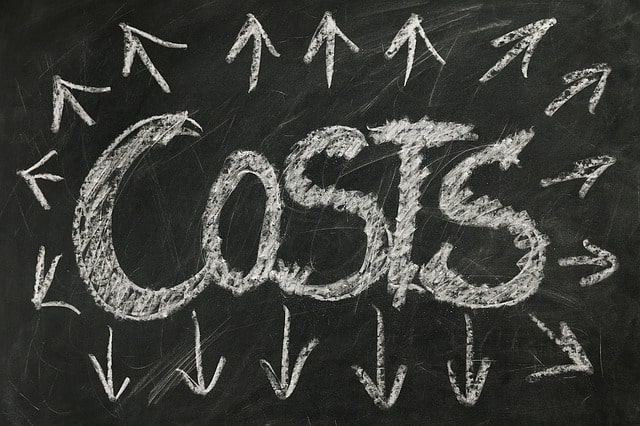We can divide the costs to produce an EDM (electronic dance music) song by the time it takes to produce a song and the economic costs. These costs depend on many variables, but it is still possible to determine some estimates. How much does it cost to produce an EDM song?
Producing an EDM song costs time, and there are economic costs. An estimation of how long it takes to produce an EDM song is 25 hours and 45 minutes. The minimum economic costs to produce an EDM song are the costs of a laptop with its electricity costs, but making more costs can make it easier.
This post gives a time and economic cost overview of producing an EDM song.
The Time It Generally Takes to Produce an EDM Song
This website has a blog post about how much time it takes to produce an EDM song, which I made with pretty good research. A summary of that post is as follows:
- An estimation is that it generally takes 20 hours to produce a song without mixing and mastering.
- An estimation is that it takes 5 hours to mix a song.
- When a person does the mastering of a song, an estimation is that it would take around 45 minutes. We can also use an automated online audio mastering service, which takes as good as almost no time to master a song.
- Many variables influence how much time it takes for someone to produce, mix, or master a song, such as a person’s experience.

The Minimal Economic Costs To Produce an EDM Song
As far as I know, most people produce music on a digital audio workstation (DAW), such as Ableton Live. According to the Digital audio workstation Wikipedia page, a DAW is software or a device we can use to produce, record, and edit audio files.
It is probably possible to produce EDM without a DAW. However, since 2012 I have been producing EDM, and in all that time, I never saw someone making a complete song without a DAW on some computer. I also recommend using a DAW as computer software since there is much information online about using such DAWs.
Some DAWs are free, and some are not. A DAW that is not free, but in my opinion, a good one is Ableton Live.
Free DAWs
There are free DAWs in which we can produce complete EDM songs, such as those mentioned by a Bedroom Producers Blog page. That page also mentions that some of the DAWs support VST plug-ins.
According to the Plug-in (computing) Wikipedia page, a plug-in is a software component that adds a computer application feature. Choosing a DAW with VST support can be a good idea since we can extend our DAW possibilities. For example, when we want to use the u-he Diva synthesizer, we can use it as a plug-in.
The Bedroom Producers Blog page shows information about DAWs, such as if they have VST plugin support and on which operating systems (OS) they can run. Some of that information is visible here in the table below.
| DAW | OS | VST support |
|---|---|---|
| Studio One Prime | Windows, macOS | no |
| Pro Tools | First | Windows, macOS | no |
| GarageBand | macOS | no |
| Waveform Free | Windows, macOS, Linux | yes |
| Cakewalk by BandLab | Windows | yes |
As the Bedroom Producers Blog page mentioned, Waveform Free has an unconventional workflow, which might be a problem when we switch from/to another DAW. Therefore, when I choose a free DAW, I would pick Cakewalk by BandLab since it also has VST support.
Choosing a Laptop
The most inexpensive computers I could find for music production are laptops. Laptops can provide a relatively cheap solution for a combination of a computer, computer screen, mouse (touchpad or trackpad), keyboard, and speakers.
As a minimum DAW requirements example, a BandLab Technologies page provides such requirements for Cakewalk by BandLab. Probably every laptop around 325 dollars (275 euros) can meet these requirements.
Electricity Costs
Of course, we might have electricity costs for powering our computer that runs a DAW. Maybe we don’t have to pay it when we already have solar panels or something like that. These costs are part of the minimal costs of producing an EDM song if we have such costs.

Optional Economic Costs To Produce an EDM Song
Producing a professionally sounding song with only a free DAW on a laptop is possible. However, by spending more, we can get results easier.
For example, external speakers sound clearer than laptop speakers, at least in most cases. By hearing the sound clearer, we can better hear the changes we make to the sound. However, we can still learn the laptop speakers’ sound flaws and learn to work with them, which takes extra time.
We can divide the optional economic costs over hardware, software, and other things. Some of these optional costs are in the sub-sections below, but it is not a complete list.
The prices in this section may not be correct since these might change over time. Also, I did the euros to dollars conversion myself, which can differ from a store where we can buy the product. However, these prices might still provide a cost indication.
Hardware
As another post on this website explained, I would always recommend studio headphones to music producers. Compared to studio monitors with acoustics, headphones can provide a good clear/flat sound for relatively low costs.
The basic studio headphones that I recommend are AKG K-702. Such basic studio headphones cost around 162 euros (170 dollars).
We may need a studio microphone when we want to record vocals with better quality than our laptop microphone. However, creating professional music with recorded vocals through a laptop microphone is possible, such as in the “In the Studio With Tristan” YouTube video. I have never recorded vocals, so I can’t recommend a microphone.
Some other optional hardware costs are:
- External audio interface. An example of an external audio interface is Focusrite Scarlett 2i2 3rd Gen, which costs around 160 dollars (152 euros).
- Studio monitors. KRK Rokit Classic 5 is an example of a studio monitor, around 256 euros (269 dollars).
- Desktop PC/monitor/mouse/keyboard, all for around 500 euros (525 dollars). Desktop PCs generally have more power than a laptop and might feel faster. However, using only an external monitor, mouse, or keyboard with a laptop could also improve our work situation.
There are some other optional hardware costs, which are arguably replaceable by cheaper software. I would probably never buy such hardware since it generally costs more than the software alternatives below and takes up too much physical space (in my opinion). Some examples of such hardware are:
- Synthesizer
- Compressor
- Limiter
- Equalizer
Software
I use some software almost daily, which is also the software I can recommend to others. Most of this software is plug-ins usable in a DAW. These recommendations are:
- Synthesizer. Some great synthesizers are Diva by u-he, Sylenth1 by LennarDigital, Spire by Reveal Sound, and Serum by Xfer Records. These synthesizers have prices from 139 euros (146 dollars) to 180 euros (189 dollars).
- Equalizer. Pro-Q 3 by FabFilter, which costs 169 euros (177 dollars).
- Compressor. Pro-C 2 by FabFilter, which costs 169 euros (177 dollars).
- Distortion/saturation. Saturn 2 by FabFilter, which costs 169 euros (177 dollars).
- Limiter. Pro-L 2 by FabFilter, which costs 169 euros (177 dollars).
- LFO Tool by Xfer Records is great for shaping the volume of sounds, and it costs 49,95 dollars (48 euros). An example use of the LFO Tool could be sidechaining (ducking sound). LFO Tool can also show waveforms, which is useful for seeing the length of sounds, as an example.
- DAW. Live Standard edition by Ableton costs 349 euros (367 dollars). The DAW I like the most, and I think that people in most tutorial videos about music production use Ableton Live.
- Sound calibration software. SoundID Reference for Headphones, by Sonarworks, costs 99 euros (104 dollars). If this software supports your headphones, it can make your headphones sound flatter (more accurate).
Other Things
As explained in another post on this website, the environment in which we listen with studio monitors impacts the sound we hear. We can improve our listening environment by improving the acoustics by placing panels or changing the listening room itself.
Prices of acoustics improvement can vary from 10 euros (12 dollars) for a panel to a completely acoustically threatened room. I don’t know the costs of such rooms.
Some people like to use sample packs. Such a pack consists of multiple sounds we can use in our productions, costing around 20 euros (25 dollars).
Closing Words
Hopefully, you have learned something from the explained time and economic cost of producing an EDM song.
If you like this post, look at some other posts on this website since you might also like them.
You can share this post when you know someone who likes to learn more about the time and economic cost of producing an EDM song.

